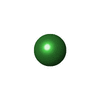+ データを開く
データを開く
- 基本情報
基本情報
| 登録情報 | データベース: PDB / ID: 9q3k | ||||||||||||
|---|---|---|---|---|---|---|---|---|---|---|---|---|---|
| タイトル | Structure of LarA-like nickel-pincer nucleotide cofactor-utilizing enzyme with a single catalytic histidine residue from Streptococcus plurextorum | ||||||||||||
 要素 要素 | LarA-like nickel-pincer nucleotide cofactor-utilizing enzyme | ||||||||||||
 キーワード キーワード | ISOMERASE / Racemase and epimerase activity / acting on hydroxy acids and derivatives / metal ion binding / catalytic activity | ||||||||||||
| 機能・相同性 | Chem-4EY / NICKEL (II) ION 機能・相同性情報 機能・相同性情報 | ||||||||||||
| 生物種 |  Streptococcus plurextorum (バクテリア) Streptococcus plurextorum (バクテリア) | ||||||||||||
| 手法 | 電子顕微鏡法 / 単粒子再構成法 / クライオ電子顕微鏡法 / 解像度: 2.2 Å | ||||||||||||
 データ登録者 データ登録者 | Subramanian, S. / Gatreddi, S. / Hausinger, R.P. / Hu, J. / Parent, K.N. | ||||||||||||
| 資金援助 |  米国, 3件 米国, 3件
| ||||||||||||
 引用 引用 |  ジャーナル: bioRxiv / 年: 2025 ジャーナル: bioRxiv / 年: 2025タイトル: Structures of two LarA-like nickel-pincer nucleotide cofactor-utilizing enzymes with a single catalytic histidine residue. 著者: Santhosh Gatreddi / Sundharraman Subramanian / Dexin Sui / Tianqi Wang / Julian Urdiain-Arraiza / Benoit Desguin / Robert P Hausinger / Kristin N Parent / Jian Hu /   要旨: The nickel pincer nucleotide (NPN) cofactor catalyzes the racemization/epimerization of α-hydroxy acids in enzymes of the LarA family. The established proton-coupled hydride transfer mechanism ...The nickel pincer nucleotide (NPN) cofactor catalyzes the racemization/epimerization of α-hydroxy acids in enzymes of the LarA family. The established proton-coupled hydride transfer mechanism requires two catalytic histidine residues that alternately act as general acids and general bases. Notably, however, a fraction of LarA homologs (LarAHs) lack one of the active site histidine residues, replacing it with an asparaginyl side chain that cannot participate in acid/base catalysis. Here, we investigated two such LarAHs and solved their cryo-electron microscopic structures with and without loaded NPN cofactor, respectively. The structures revealed a consistent octameric assembly that is unprecedented in the LarA family and unveiled a new set of active site residues that likely recognize and process substrates differently from those of the well-studied LarAHs. Genomic context analysis suggested their potential involvement in carbohydrate metabolism. Together, these findings lay the groundwork for expanding the breadth of reactions and the range of mechanisms of LarA enzymes. | ||||||||||||
| 履歴 |
|
- 構造の表示
構造の表示
| 構造ビューア | 分子:  Molmil Molmil Jmol/JSmol Jmol/JSmol |
|---|
- ダウンロードとリンク
ダウンロードとリンク
- ダウンロード
ダウンロード
| PDBx/mmCIF形式 |  9q3k.cif.gz 9q3k.cif.gz | 724.8 KB | 表示 |  PDBx/mmCIF形式 PDBx/mmCIF形式 |
|---|---|---|---|---|
| PDB形式 |  pdb9q3k.ent.gz pdb9q3k.ent.gz | 604 KB | 表示 |  PDB形式 PDB形式 |
| PDBx/mmJSON形式 |  9q3k.json.gz 9q3k.json.gz | ツリー表示 |  PDBx/mmJSON形式 PDBx/mmJSON形式 | |
| その他 |  その他のダウンロード その他のダウンロード |
-検証レポート
| アーカイブディレクトリ |  https://data.pdbj.org/pub/pdb/validation_reports/q3/9q3k https://data.pdbj.org/pub/pdb/validation_reports/q3/9q3k ftp://data.pdbj.org/pub/pdb/validation_reports/q3/9q3k ftp://data.pdbj.org/pub/pdb/validation_reports/q3/9q3k | HTTPS FTP |
|---|
-関連構造データ
| 関連構造データ |  72200MC  9q3jC M: このデータのモデリングに利用したマップデータ C: 同じ文献を引用 ( |
|---|---|
| 類似構造データ | 類似検索 - 機能・相同性  F&H 検索 F&H 検索 |
- リンク
リンク
- 集合体
集合体
| 登録構造単位 | 
|
|---|---|
| 1 |
|
- 要素
要素
| #1: タンパク質 | 分子量: 56339.324 Da / 分子数: 8 / 由来タイプ: 組換発現 由来: (組換発現)  Streptococcus plurextorum (バクテリア) Streptococcus plurextorum (バクテリア)発現宿主:  Lactococcus lactis (乳酸菌) / 株 (発現宿主): NZ3900 Lactococcus lactis (乳酸菌) / 株 (発現宿主): NZ3900#2: 化合物 | ChemComp-NI / #3: 化合物 | ChemComp-4EY / 研究の焦点であるリガンドがあるか | Y | Has protein modification | Y | |
|---|
-実験情報
-実験
| 実験 | 手法: 電子顕微鏡法 |
|---|---|
| EM実験 | 試料の集合状態: PARTICLE / 3次元再構成法: 単粒子再構成法 |
- 試料調製
試料調製
| 構成要素 | 名称: Apo LarA-like nickel-pincer nucleotide cofactor-utilizing enzyme タイプ: COMPLEX / Entity ID: #1 / 由来: RECOMBINANT | |||||||||||||||
|---|---|---|---|---|---|---|---|---|---|---|---|---|---|---|---|---|
| 分子量 | 実験値: NO | |||||||||||||||
| 由来(天然) | 生物種:  Streptococcus plurextorum (バクテリア) Streptococcus plurextorum (バクテリア) | |||||||||||||||
| 由来(組換発現) | 生物種:  Lactococcus lactis (乳酸菌) / 株: NZ3900 Lactococcus lactis (乳酸菌) / 株: NZ3900 | |||||||||||||||
| 緩衝液 | pH: 7.8 | |||||||||||||||
| 緩衝液成分 |
| |||||||||||||||
| 試料 | 濃度: 1.5 mg/ml / 包埋: NO / シャドウイング: NO / 染色: NO / 凍結: YES | |||||||||||||||
| 試料支持 | グリッドの材料: COPPER / グリッドのタイプ: Quantifoil R2/2 | |||||||||||||||
| 急速凍結 | 装置: FEI VITROBOT MARK IV / 凍結剤: ETHANE / 湿度: 100 % / 凍結前の試料温度: 277.15 K |
- 電子顕微鏡撮影
電子顕微鏡撮影
| 実験機器 |  モデル: Talos Arctica / 画像提供: FEI Company |
|---|---|
| 顕微鏡 | モデル: FEI TALOS ARCTICA |
| 電子銃 | 電子線源:  FIELD EMISSION GUN / 加速電圧: 200 kV / 照射モード: FLOOD BEAM FIELD EMISSION GUN / 加速電圧: 200 kV / 照射モード: FLOOD BEAM |
| 電子レンズ | モード: BRIGHT FIELD / 倍率(公称値): 130000 X / 最大 デフォーカス(公称値): 3000 nm / 最小 デフォーカス(公称値): 800 nm |
| 試料ホルダ | 凍結剤: NITROGEN 試料ホルダーモデル: FEI TITAN KRIOS AUTOGRID HOLDER |
| 撮影 | 電子線照射量: 44.71 e/Å2 フィルム・検出器のモデル: FEI FALCON IV (4k x 4k) 撮影したグリッド数: 1 / 実像数: 3949 |
- 解析
解析
| EMソフトウェア |
| ||||||||||||||||||||||||
|---|---|---|---|---|---|---|---|---|---|---|---|---|---|---|---|---|---|---|---|---|---|---|---|---|---|
| CTF補正 | タイプ: PHASE FLIPPING AND AMPLITUDE CORRECTION | ||||||||||||||||||||||||
| 対称性 | 点対称性: C4 (4回回転対称) | ||||||||||||||||||||||||
| 3次元再構成 | 解像度: 2.2 Å / 解像度の算出法: FSC 0.143 CUT-OFF / 粒子像の数: 571000 / 対称性のタイプ: POINT | ||||||||||||||||||||||||
| 拘束条件 |
|
 ムービー
ムービー コントローラー
コントローラー




 PDBj
PDBj



